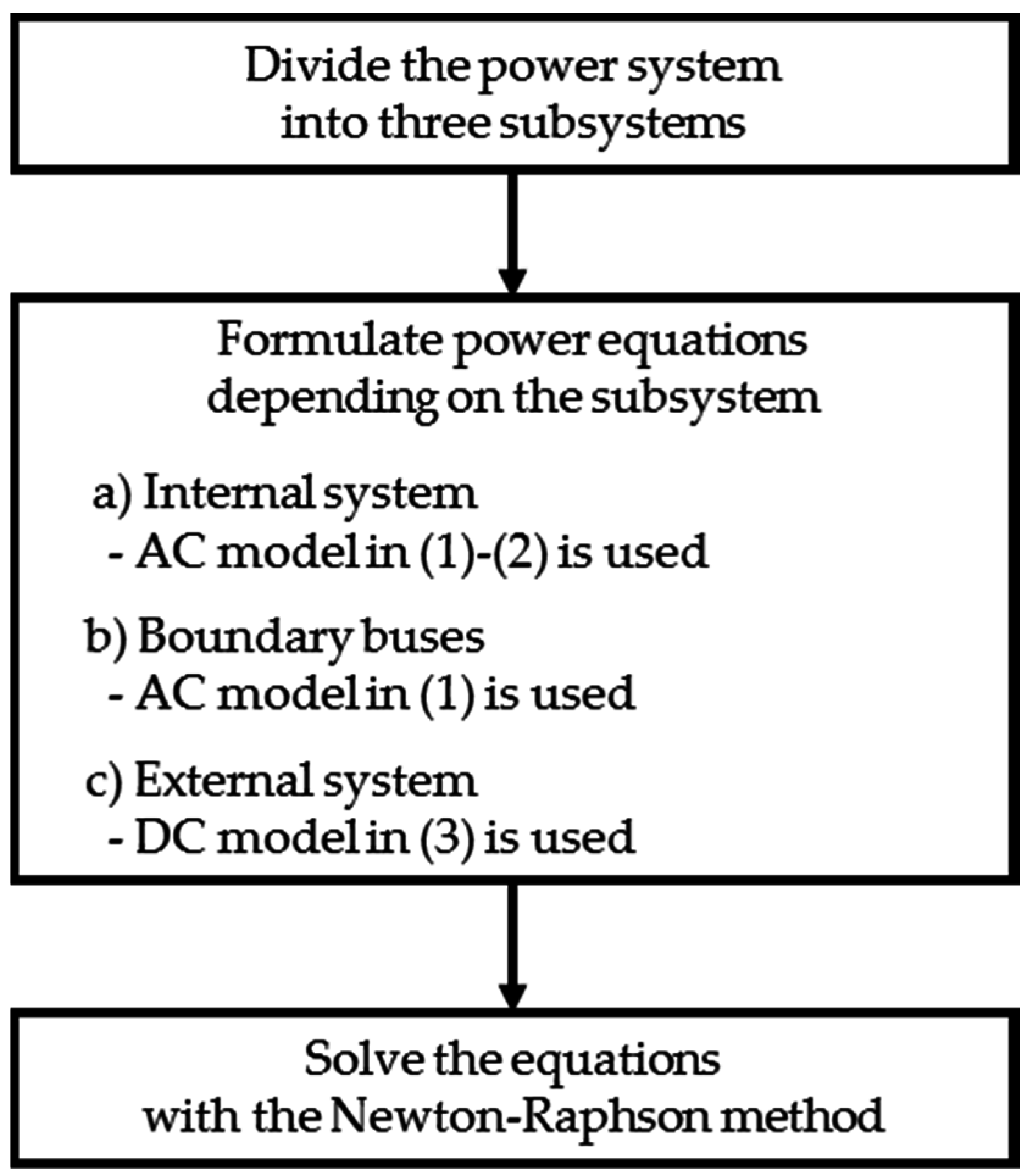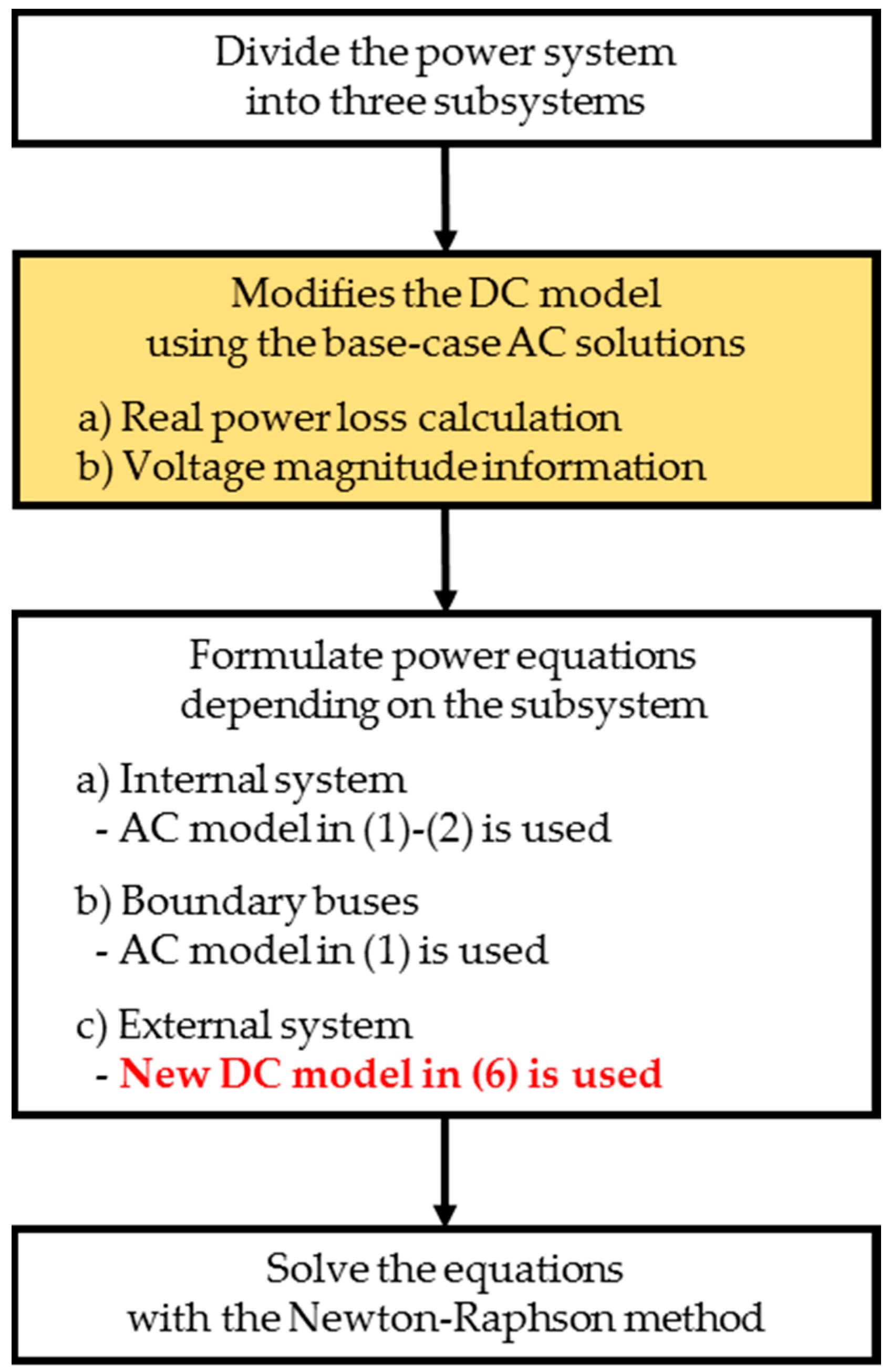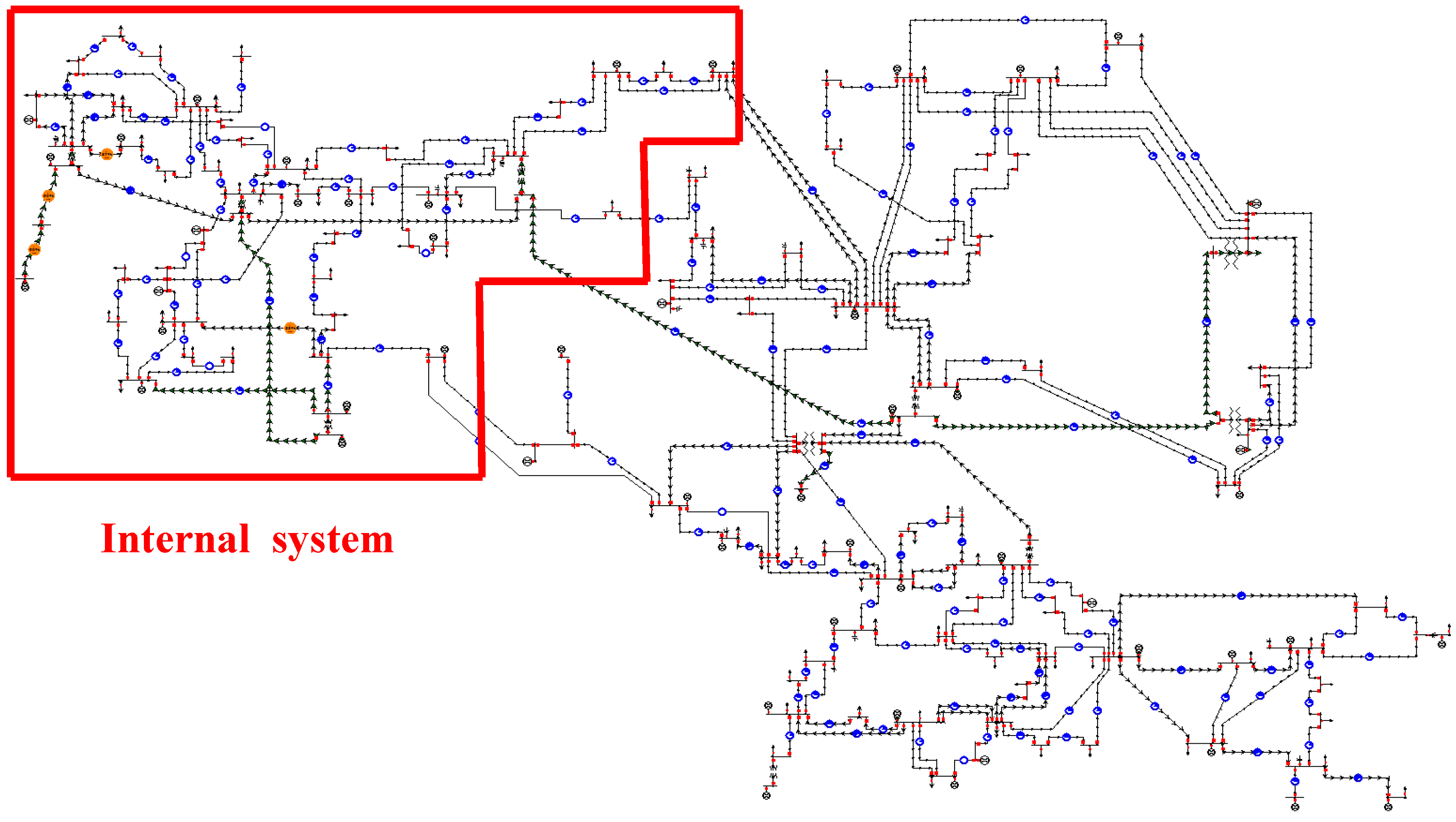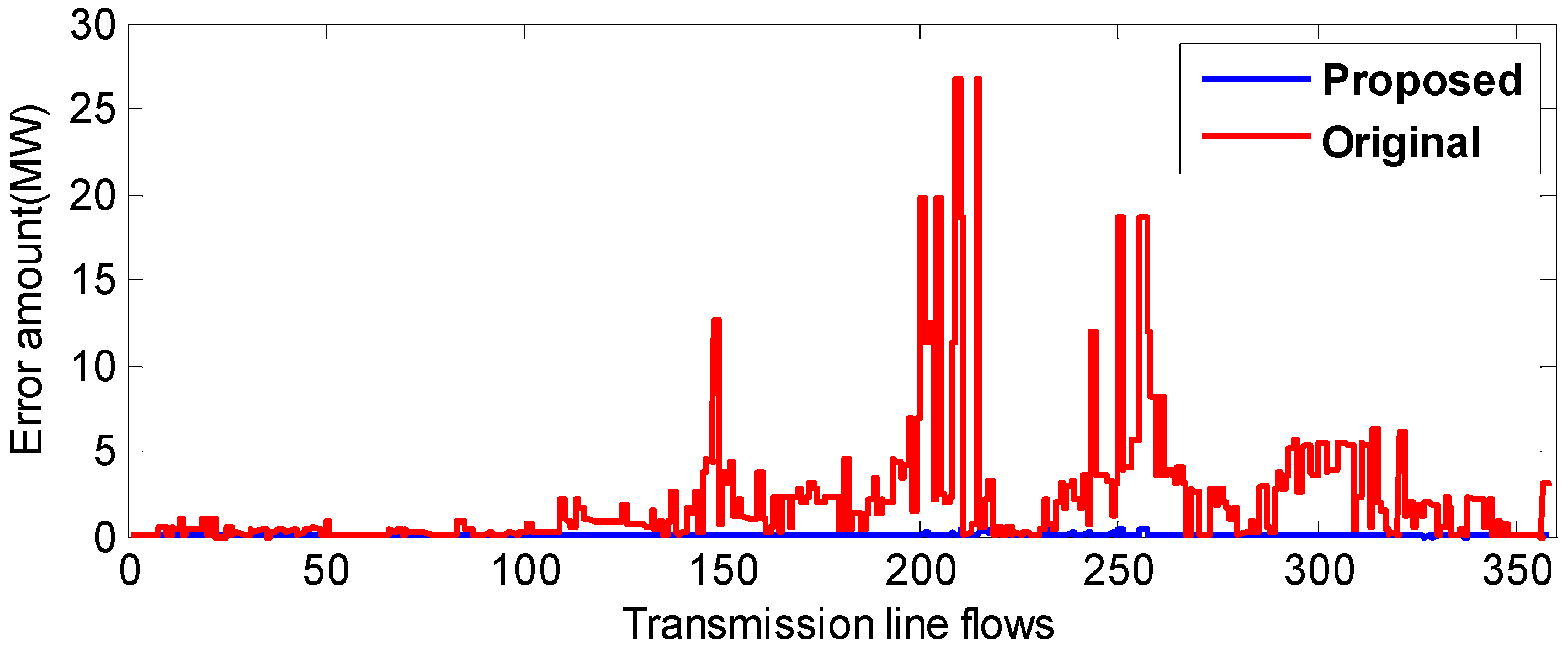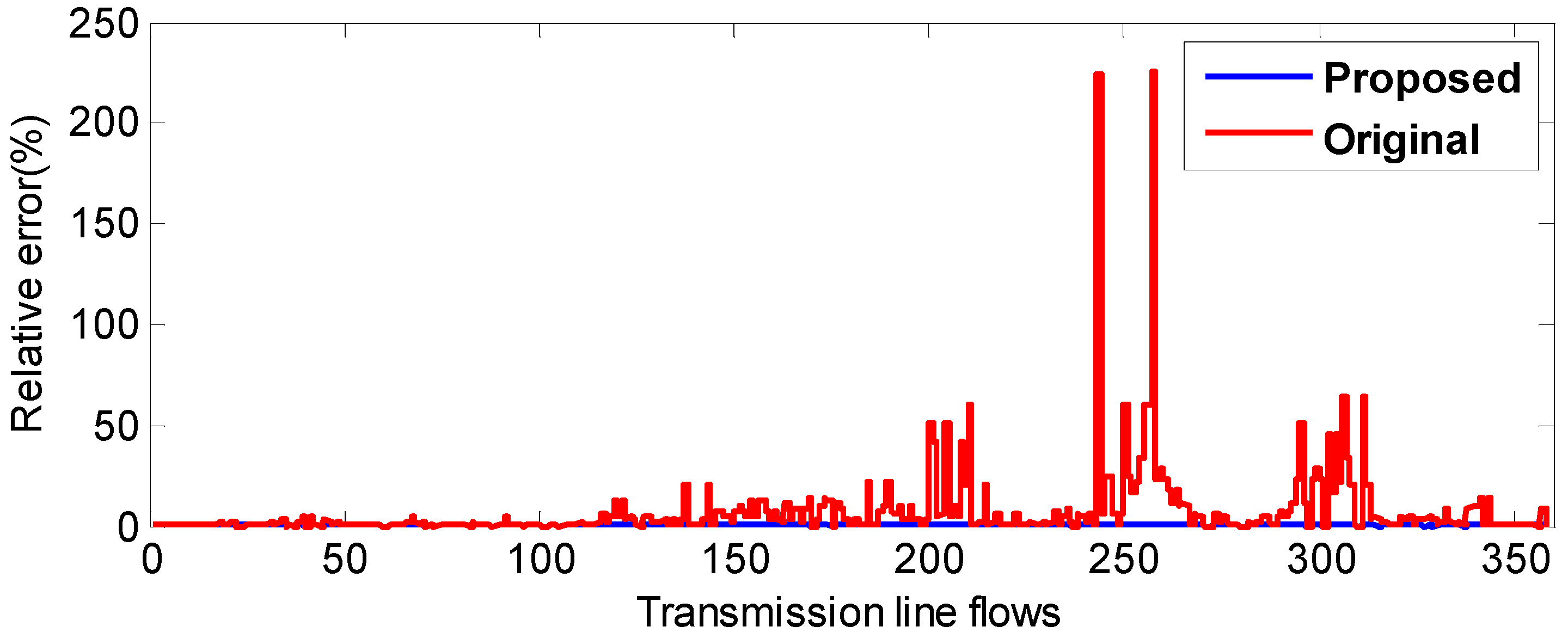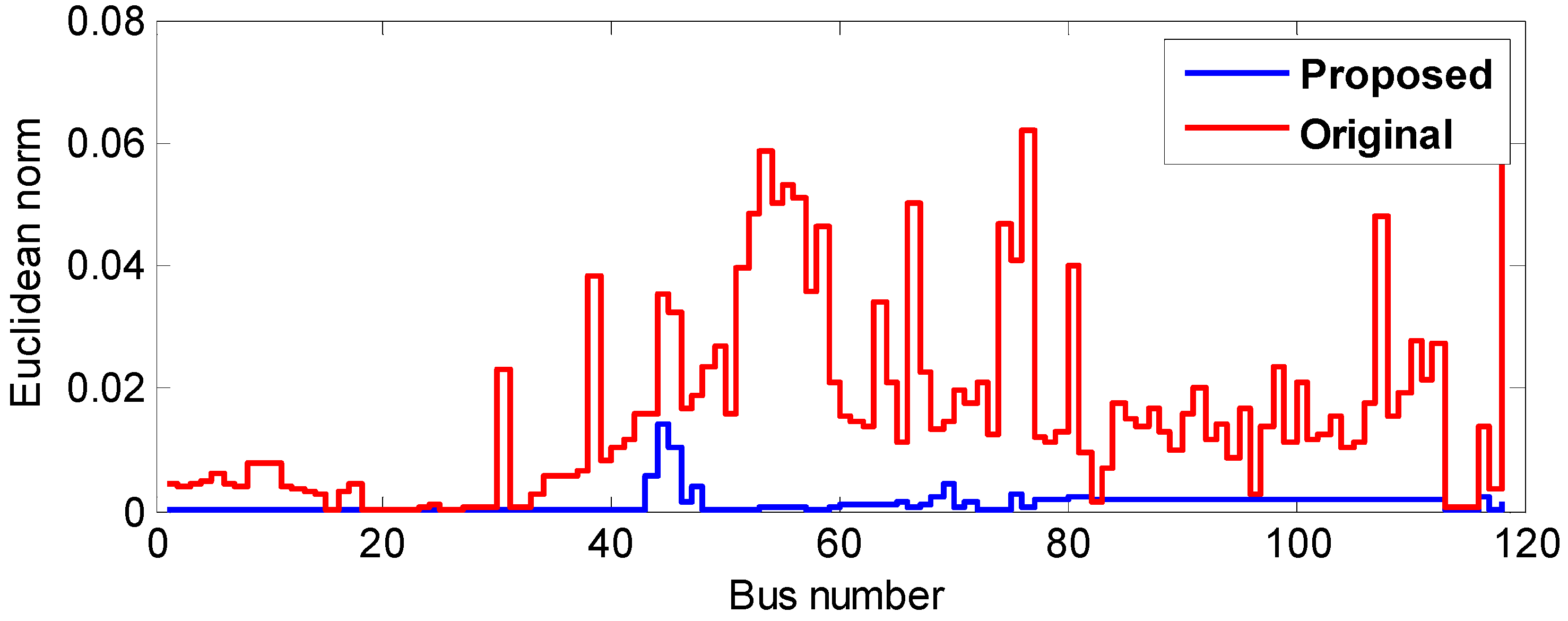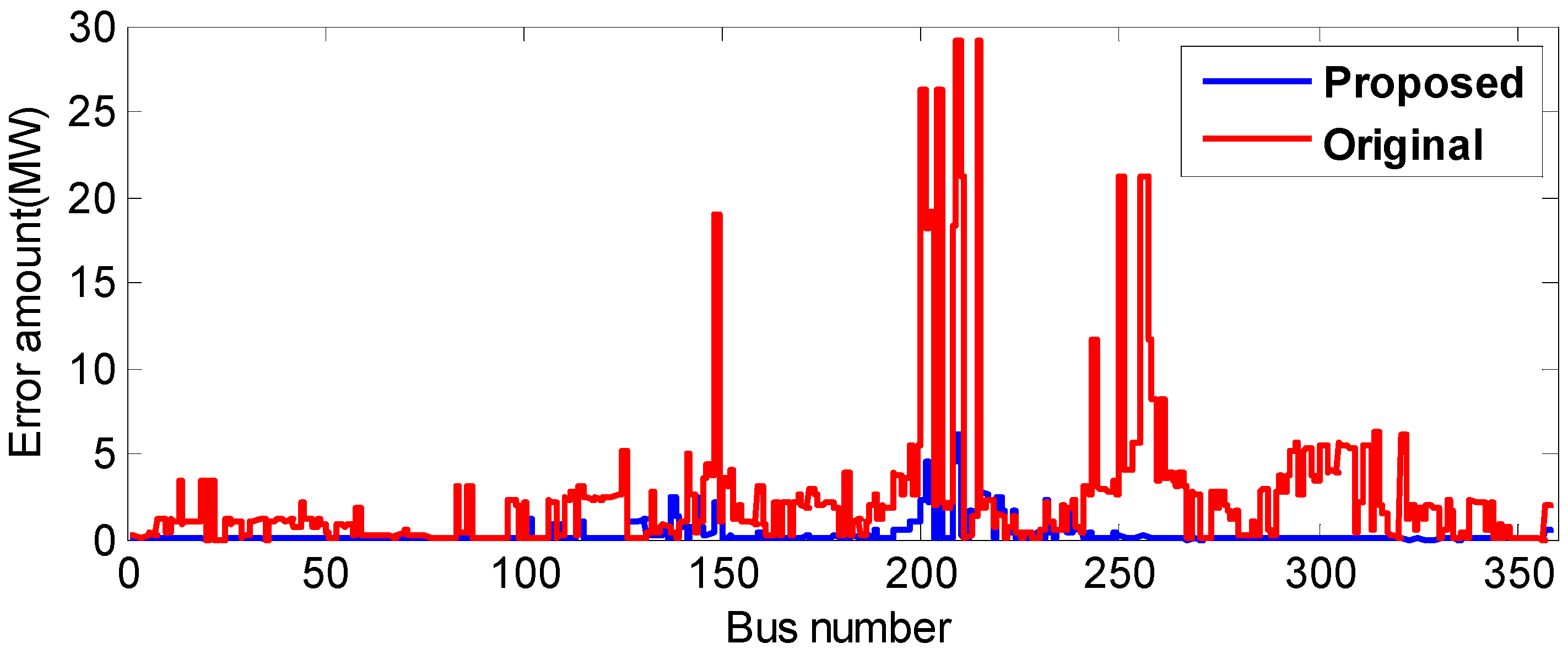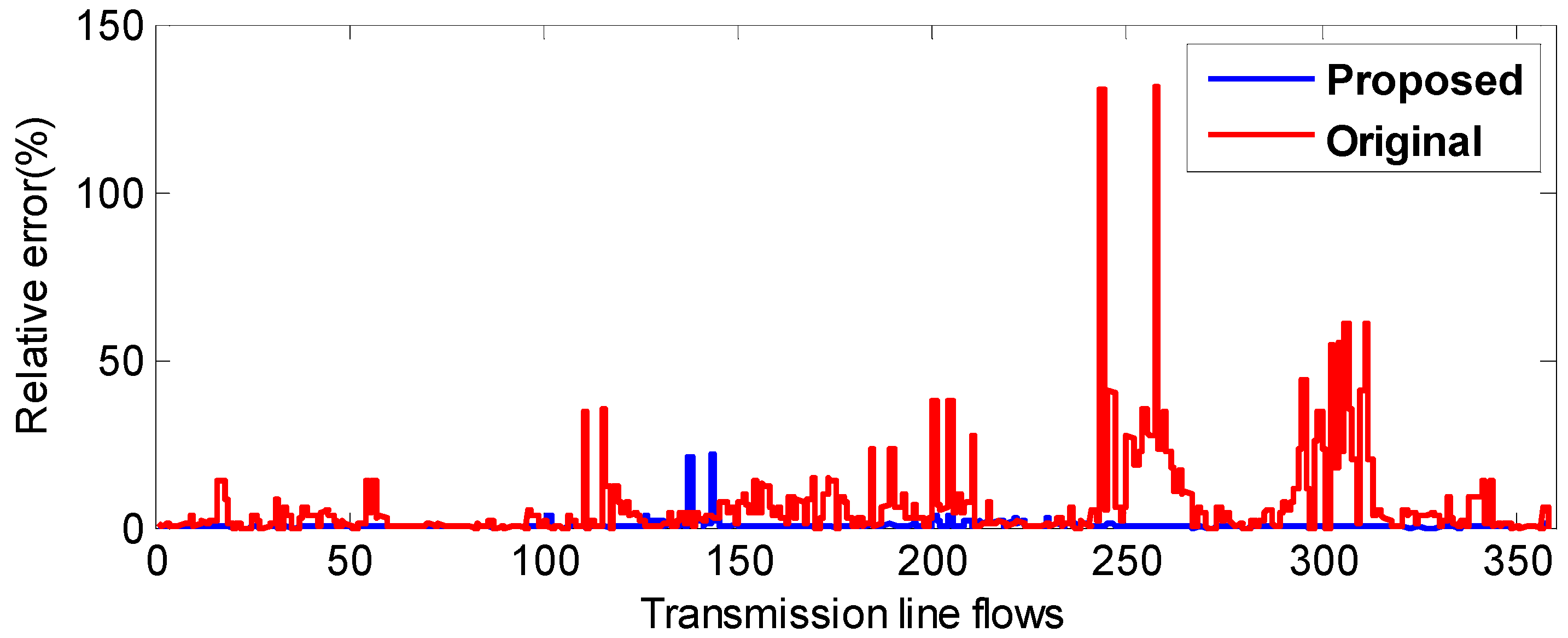1. Introduction
Steady-state power flow analysis is a fundamental tool and the most frequently used routine in power system planning, operations, and control. It provides the bus voltages of each bus, and the power flows through a transmission network for a specified load and generator information. With this analysis, various contingencies and expansion plans can be carefully explored, and security indexes such as component overloading and power transfer capability can be evaluated. However, owing to interconnections, modern electric power systems have become increasingly complex, large-scale systems comprising numerous components. Power system equations are inherently nonlinear. The complexity issues in the analysis have grown and become even more burdensome with the recent integration of renewable energy sources. Thus, the need for the development of rapid and precise power system analysis tools has become critical [
1].
The primary and the most accurate approach for power flow analysis models the electric power networks with a set of nonlinear power balance equations; this is typically referred to as the ac model. Based on Kirchhoff’s law and the definition of complex power, nonlinear real and reactive power balance equations are derived for each bus. A large number of equations are required to represent the modern large power systems. The set of nonlinear equations is usually solved using iterative techniques such as Newton’s method. Hence, the ac model is computationally expensive, especially for the contingency analysis of large power systems [
2].
Complexity reduction in power flow studies has been attempted with many approximate models, which are based on the physical properties of the power systems [
3,
4,
5,
6]. The most common examples include the decoupled and dc power flows. The decoupled power flow utilizes a remarkable property of the power system: the interactions between the real power and the bus voltage angle and the interactions between the reactive power and the bus voltage magnitude are very strong. This property simplifies the Jacobian matrix, which results in rapid power flow solutions. While the decoupled method requires more iterations to converge, it usually provides much faster results than the conventional Newton’s method with the ac model [
6].
Furthermore, the dc model is the simplest and fastest power flow modeling approach. The dc model focuses only on the real power flow, and it changes the nonlinear power flow equations to linear ones. Therefore, the number of equations can be reduced and iterative techniques are not required to find the power flow solutions [
7]. Because of its superior computational benefits, this traditional dc model is widely used in various power system applications. Examples include security constrained unit commitment (SCUC), economic dispatch, and real-time contingency analysis. However, the dc model offers approximate solutions only, particularly when the X/R ratios are not big enough or the voltage profiles are not uniform [
8].
Many different versions of the dc power flow models have been proposed [
8,
9,
10,
11,
12]. These can be classified into hot-start and cold-start models. The hot-start model is formulated when the initial ac power flow solution is available, while the cold-start models are derived when the initial ac solution is not available. Hot-start models show better simulation accuracies because the inaccuracy of the dc model can be compensated using the initial ac solution. The hot-start models are often used in short- and medium-term operations and planning simulations. On the contrary, cold-start models are state-independent because the base-case information is not incorporated. Thus, flat voltages are approximated and net losses are neglected. The classical dc power flow is included in cold-start models. SCUC, financial right auction, and long term planning studies are typical applications of the cold-start models.
A hybrid power flow method has been proposed by the author [
13]. The mixed approach uses a combination of ac and dc models, depending on the area of interest. The method aims to reduce the computational demands with the simpler dc model, as well as to maintain a high level of simulation accuracy using the accurate ac model. The mixed approach was originally developed based on the cold-start dc model. The errors originating from the use of the classical dc model may propagate to the area of interest where accurate simulation outcomes are required; thus, the simulation accuracy might not be satisfactory. Under certain power system conditions, a significant loss of simulation accuracy can occur if the original mixed approach is used. For power system operations and control where careful examination is required, inaccuracies may cause severe problems. For economic studies, even small errors in the power flow calculations may lead to substantial economic losses when aggregated over the year. A more robust approach to provide precise solutions should be developed.
In practical power system operations, various applications are investigated with prior knowledge about the present power system conditions including initially solved ac power flow solutions. The base-case ac solutions can be obtained from a state estimator, which is an EMS (Energy Management System) application program that identifies the current operating state of the system [
14,
15]. This additional information can be utilized to construct the hot-start dc models, which take the place of the cold-start model in the original mixed approach.
This paper presents a new method to enhance the simulation accuracy of the mixed power flow analysis. In the proposed method, the traditional dc model is modified by incorporating the base-case ac solution which is commonly available. The real power losses, which are neglected in the classical dc model, are compensated to maintain the overall system balance. In addition, the new approach includes the voltage magnitude information instead of the one-per-unit assumption. The modifications are helpful for minimizing the error propagation from the use of the traditional dc model. Thus, the simulation accuracy can be improved. The superior computational benefits can also be preserved with a linear formulation of the dc model.
The remainder of this paper is organized as follows.
Section 2 presents a brief overview of the mixed power flow analysis. The enhanced method is proposed along with the problem definition in
Section 3.
Section 4 illustrates the simulation results using the IEEE 118-bus system. Various system conditions are studied to evaluate the performance of the proposed method. The conclusions are presented in
Section 5.
3. The Proposed Method
3.1. The Accuracy Problem
The mixed approach might have problems in the accuracy of the simulation outcomes, although an exact ac model is used in the internal system. Errors originating from the simplified dc model may be transferred to the internal system. In the original mixed approach, careful considerations were made to minimize the error propagation by formulating the ac power flow equations at the boundary buses composed of the boundaries between the two systems. However, the errors from the use of a dc model cannot be completely avoided under certain conditions, and the mixed approach fails to provide accurate simulation outcomes. The accuracy problem arises from the excessive approximations made in the dc model, especially from the neglect of the real power losses. Static power flow analysis assumes that the real and reactive powers are balanced in the entire system, and this means that the total generation is equal to the total consumption plus losses. Ignorance of the real power losses reduces the total amount of generation. Although the real power losses on a transmission line are relatively small, the cumulative sum of these losses might be significant, particularly when a large power system is under study. For example, if the external area does not have enough real power injections, the real powers required to maintain the system balance must be provided from the internal system. The use of a dc model reduces the amount of real power injections from the internal system, and this brings about a reduction in the accuracy of the simulation outcomes in the internal system.
The mixed approach was originally developed with a cold-start dc model assuming that the initial ac solutions were not available. However, in practical power system operations, various applications are investigated with prior knowledge about the present power system conditions, which can be obtained from a state estimator. This useful information can be positively utilized to sort out the accuracy problems in the original mixed approach.
3.2. The Proposed Approach
The proposed method aims to improve the simulation accuracy of the mixed approach, while retaining its computational benefits. Simulation accuracy can be improved by preserving the real power balances, and the computational advantages can be sustained by using a linear model. The proposed approach modifies the traditional dc model to a new model assuming that the base-case ac solutions of the entire system are available.
3.2.1. Loss Modeling of the DC Model
The real power losses are simply modeled by calculating the differences between the net power injections in the ac and the dc models, and the loss model is provided in Equation (4). The loss information is calculated using the initial ac power flow solution. The superscript b denotes the information from the base-case ac solutions.
3.2.2. Incorporation of Voltage Magnitudes into the DC Model
The voltage magnitude information from the available base-case ac solutions is utilized to improve the dc power flow model, instead of assuming a per-unit voltage magnitude. Voltage magnitudes in power systems are closely related to the reactive powers, which are not considered in the external system. Therefore, this utilization produces a positive effect while dealing with reactive powers; thus, it helps the proposed method in enhancing the accuracy.
3.2.3. The New DC Model
The new dc model shown in Equation (6) incorporates the voltage magnitude information and loss modeling into the conventional dc model. This new model is constructed with the base-case information, which is assumed to be available.
3.2.4. The Procedure of the Proposed Approach
The procedure of the proposed approach is almost the same as that of the original mixed approach. The difference is that the new dc model in Equation (6) is applied for the external system. Overall procedure of the proposed approach is shown in
Figure 2. The proposed approach retains the linear formulation of the dc model. The construction of the new dc model requires minor additional computations to incorporate the base-case ac solutions and is made once before running the simulation. More accurate simulation outcomes can be obtained with little extra computational effort.
5. Conclusions
The mixed approach is an extremely attractive power flow analysis model that can speed up the simulation with a simple dc model as well as maintain a high level of simulation accuracy with an accurate ac model. However, the use of the conventional dc model developed with a large amount of simplifications inevitably introduces errors in simulation results. In this paper, an enhanced method is proposed to improve the simulation accuracy of the mixed approach with minor extra computations. The proposed method utilizes the base-case information, which is commonly available, for power system planning, operations, and control. With the available ac solutions, the proposed method modifies the conventional dc model used in the original mixed approach into an advanced model. The new dc model incorporates the real power losses and the voltage magnitude information, which are the most influential factors affecting the accuracy of the dc model. The compensation of real power losses is helpful in preserving the real power balance of the system. The incorporation of voltage magnitude information has an impact on considering the reactive power flows, which are totally neglected in the conventional dc model. Thus, more accurate simulation outcomes can be expected by minimizing the loss of accuracy in the conventional dc model. The superior computational benefits can be retained with a linear formulation of the dc model. The test simulation with the IEEE 118-bus system proved that the proposed approach achieved better simulation accuracy than the original mixed approach, while preserving the advanced computational benefits. The proposed approach can be very useful for applications where accurate and fast simulation outcomes are of great importance.
